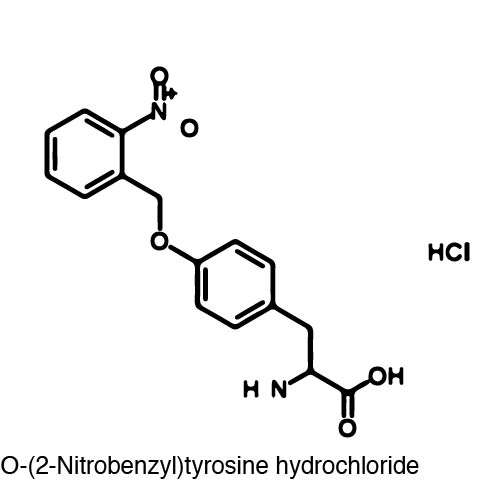| - | The tyrosine residue (Tyr639) that was replaced by ONBY lies on a crucial position, called the O-helix, that blocks incoming nucleotides from reaching the active site. The Tyr639 in the O-helix is responsible for two critical roles roles in polymerization. First, the tyrosyl-OH coordinates Mg2+ to interact with the 2’-OH of the incoming nucleotide to assure discrimination between deoxyribose and ribose substrates. Second, the Tyr639 moves the newly synthesized RNA out of the catalytic site and prepares for the next NTP to be inserted. These roles were determined to be critical through mutational analysis. Polymerases that lacked the Tyr639 residue resulted in a loss of function. Furthermore, because of the bulky nature of ONBY, its incorporation at the 639 position blocks incoming nucleotides from reacting in the active site. This group can be removed by brief irradiation by non-phototoxic UV light, which would restore RNAP activity. In order to introduce the photocaged tyrosine into the cell, a synthetase/tRNA pair that is specific for ONBY must be transformed into the bacteria. In order to do this, a Methanococcus jannaschii synthetase/tRNA pair was evolved in order to incorporate ONBY, but not any of the other 20 natural amino acids. In order to evolve the pair, six residues (Tyr 32, Leu 65, Phe 108, Gln 109, Asp 158, and Leu 162) on the synthetase were randomized and selected for its ability to selectively incorporate ONBY. The following are the specific changes made to the amino acid sequence of the synthetase: Tyr 32→Gly 32, Leu 65→Gly 65, Phe 108→Glu 108, Asp 158→Ser 158, and Leu 162→Glu 162. The Asp 158→Ser 158 and Tyr 32→Gly 32 mutations were likely involved in the loss of hydrogen bonds with the natural substrate, which would disfavor binding to natural tyrosine. On the other hand, the Tyr 32→Gly 32 and Leu 65→Gly 65 mutations likely increase the size of the substrate-binding pocket to accommodate the bulky o-nitrobenzyl group. | + | The tyrosine residue which is replaced by ONBY lies on a crucial position on the O-helix and has been proved to be essential for polymerization. The Tyr639 residue in the O-helix is responsible for two major roles. First, this tyrosine residue discriminates between deoxyribose and ribose substrates. Second, Tyr639 is responsible for moving newly synthesized RNA out of the catalytic site and preparing for the next NTP to be inserted. These functions of the O-helix were shown to be essential through mutational analysis. Because the loss of this tyrosine residue in the active site leads to a non-functional polymerase, Tyr639 proved to be a good candidate for incorporating a photocaged amino acid. |
| | + | Because of the bulky nature of ONBY, its incorporation at position 639 essentially halted the activity of the T7 polymerase. However, the bulky ONB group is able to be removed through irradiation with 365 nm light. The wavelength of light used to "decage" the amino acid proved to be another advantage because 365 nm light is not toxic to the cell. Once the ONB group is removed, a normal tyrosine residue is left which restores RNA polymerase activity. |
 "
"


